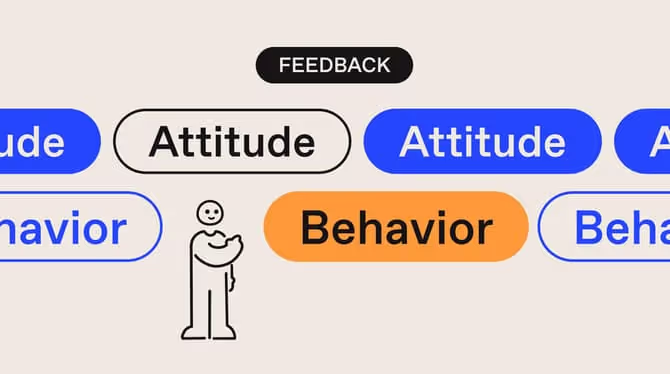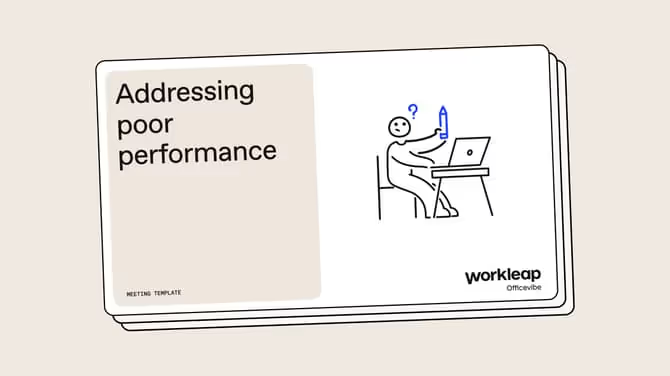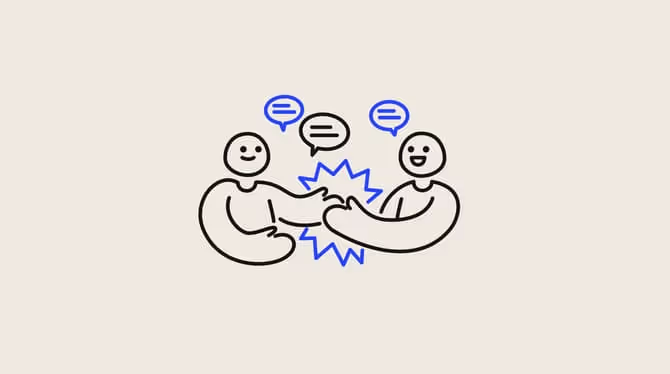15 Sample email templates to address (and improve) employee performance
Discover Workleap Officevibe's benchmark report on 12 key employee engagement metrics

Building strong relationships with your team members and gaining a deep understanding of their unique challenges and aspirations is essential. Central to this process is the continuous exchange of meaningful conversations, some of which may require careful planning and personalized attention.
In this article, you'll find a collection of 15 manager email examples designed to help you improve communication and navigate performance expectations with your employees. You can use them straightforwardly as templates, or extract their full value by seeing them as versatile preparation guides for any type of interaction.
As extra support, we also provided preliminary notes alongside each template, offering guidance on language, clarity, and tone so you can handle every situation with ease and effective communication. We're sure you'll find a great sample email to employee to improve performance.
The importance of transparent communication for employee performance management
Unlocking the power of effective communication is at the core of successful performance management. It's the catalyst for driving individual and team excellence and building an effective performance improvement plan as great communication fosters clarity, productivity, and strong relationships.
- Facilitates clarity and understanding: Effective communication plays a pivotal role in performance management by providing a clear framework for defining performance standards to meet expectations, delivering constructive feedback, and setting meaningful performance goals. It creates a shared understanding that drives individual and team success.
- Fosters productivity: When communication practices are optimized, they contribute to increased productivity. By effectively conveying roles, responsibilities, and how to meet performance standards to reach expectations, employees gain a clear sense of purpose and direction, enabling them to work more efficiently and contribute their best efforts toward organizational goals.
- Enhances relationships: Strong relationships between managers and employees are built on effective communication. Open and transparent dialogue fosters trust, understanding, and mutual respect, creating a positive and collaborative workplace environment. These connections lay the foundation for a motivated and engaged team that thrives together.
⭐️ The foundation of healthy work dynamics is healthy communication. And positive work environments foster better employee engagement. From trust building, to active listening, to being clear on expectations, read our tips to boost communication.
The significance of emails as a formal communication tool in the workplace
From providing a formal record and enabling asynchronous communication to offering a broad reach, emails play a vital role in promoting accountability, facilitating thoughtful exchanges, and efficiently sharing information within teams and organizations.
- Provide a formal record: Emails serve as a formal document, capturing important conversations and decisions. This not only aids in accountability but also promotes transparency, ensuring that critical information is documented and accessible when needed via their personnel file.
- Enable asynchronous communication: One of the advantages of emails is their ability to facilitate asynchronous communication (communication that isn't time dependent). Emails allow for messages that don't require immediate responses, giving recipients the time to craft thoughtful replies and contribute to meaningful discussions at their convenience.
- Broad reach: With the capability to reach multiple recipients simultaneously, emails offer a highly efficient means of disseminating information or updates within a team or even across the entire organization. They ensure that important messages can be shared with the intended audience with the click of a button.
Key elements to include in an email about employee performance
With these templates, you can spend less time and energy thinking about how you want to write your email, and more time on big-picture, productive work.
Just remember, these are mere guidelines to start and respond to conversations. It's important to tweak them based on the individual and context.
{emphasize}
Before you send a formal document, ask yourself:
- Is this employee more communicative by email, instant message, or in one-on-one conversation?
- Should this conversation come at the beginning of the day/week, so as to motivate them right away? Or at the end of the day/week, so as to give them time to reflect?
- Does this employee respond well to directness? Or is a bit of small-talk a good way to warm them up?
- Does the subject line use language that is fear inducing?
Most importantly: Remember why you hired this employee, and what about them and their work do you find amazing. Keep that front and center in your mind when preparing for a talk.
{emphasize}
Here's what you should include in your email:
- Clear subject line: Ensure the subject line clearly indicates the purpose of the email, such as "Performance Review" or "Feedback Session."
- Professional greeting: Begin the email with a respectful and professional greeting, addressing the employee directly.
- Specific performance feedback: Include specific examples of the employee's work performance, highlighting both positive aspects and areas needing improvement.
- Actionable steps: Provide clear and actionable next steps that the employee can take to improve their poor performance, as well as your own action items, so that a personalized performance improvement plan can be adhered to.
- Open-ended invitation: Encourage the employee to ask questions or discuss their performance further, fostering a two-way communication process.
- Professional closing: Conclude the email on a positive note, offering continued support to the employee as they embark in their employee performance improvement plan.
Email samples to address an employee's poor performance or a performance issue
Addressing poor performance is not something you want to delay. You both want to get to the root cause of what is affecting employee performance and quickly implement solutions to mitigate this problem, as poor performance can have a ripple effect on teams and your company's overall performance. Understanding the "when" and "why" of any employee performance issue will help you tailor the right message.
- When to send emails about employee's poor performance: Constructive feedback emails should ideally be sent soon after a particular incident or employee performance review period where poor performance was noted. This helps ensure the context is fresh for both you and the employee, making the feedback more relevant and impactful.
- Why send constructive feedback emails: Remember that everything has to serve a purpose. The primary reason for writing a constructive feedback email is to help improve an employee's performance or behavior. It allows you to express concern about poor performance in a structured, thoughtful manner, providing clear guidance on areas needing improvements and promoting professional growth.
1. When an employee continuously shows up to work tired or lacking energy
Work fatigue or burnout might be caused by outside-work factors, and you don't want to appear too nosey. However, a tired employee (one who lacks energy for a while) cannot work at their optimal capacity, which, as a manager, is your job to fix.
Choose your words wisely to get at the right level of personal interest. And as we'll see, a common refrain will be to express how your door is always open. When writing such emails, ending on a positive note is important.
{emphasize}
Email template:
Hey _______,
I noticed that you seemed a little tired the last few days, is everything okay?
I don't mean to get too personal, but if there is anything going on outside of work that you need time to deal with, just let me know. Your well-being is the priority. Just know that if you ever need to chat about anything, I'm here for you.
[Your name]
{emphasize}
2. When an employee continuously shows up to work late
Consistent tardiness affects can really make a dent on employee performance and it can also be upsetting to their coworkers. That said, you don't want to single anyone out by using language that pits the employee against the team.
Again, express that you're open to hear them out and eager to help. Avoid reproachful words like “unacceptable” and “unfair.”
{emphasize}
Email template:
Hey _______,
I noticed that you've been getting to work late the last few days. I think that might make things difficult for your coworkers who depend on you. Is everything alright?
If there's anything on your mind or anything I can help with, let me know!
Thanks!
{emphasize}
3. When an employee misses too many deadlines
Since employees are typically aware of missed deadlines, there's no need to tiptoe around the issue. It's best to address it directly and honestly, ensuring clear communication and accountability.
If you need to email an employee to improve their poor performance, ask if there's a good reason for missing their deadlines, and be clear you're open to listening to them without judgment. Some times employees miss deadlines because other priorities come up or because the original deadlines are unrealistic. When this happens, let them know they can come to you to reorganize their workloads and timelines to better manage other coworkers' or teams' expectations. But if it's just a general slacking off, let them know that, as a manager, you have a responsibility to fix the situation, and you will.
{emphasize}
Email template:
Hey _______,
How's it going?
I want to discuss your missed deadlines. If there's anything that's been preventing you from focusing and you want to discuss it, I'm all ears and happy to help out in any way I can.
I can always manage your workload and move timelines around to avoid missing deadlines on our priority projects.
Even if it's just a matter of your work motivation levels, know that I am here for you and will help find a solution.
{emphasize}
{emphasize}
💡Tip: Remember, the first step to making sure your employees are on the ball when it comes to deadlines is to clearly set and communicate expectations before a task or project. Otherwise, as a manager, you are just as responsible if your employee fails to meet these unclear standards.
{emphasize}
4. When an employee takes too much time off
You want to encourage a good work-life balance but need to be on guard for employees who may take advantage. Still, you never know the reasons behind the absenteeism, so it's important to tread carefully.
Mind your tone and be cautious before jumping to conclusions. Use language that expresses giving them the benefit of the doubt. You won't demand all the details, but if it's a work issue, you must express the importance of them being open with you.
{emphasize}
Email template:
Hey _______,
How's everything going?
You know we encourage work-life balance and are happy to let you take time off. However, from what I've noticed, you've been taking quite a bit of time off.
If there's anything you'd like to talk about, please let me know. I'd be happy to help in any way I can.
Going forward, you'll need to be more present to better support your team. That's how we'll all achieve our goals together!
Thanks!
{emphasize}
5. When an employee demonstrates difficulty in receiving feedback
This email is likely to come after you've had to dish out feedback about poor performance and the employee was not receptive.
While you can't walk back on your negative feedback, you should be mindful and explain that your intention is not to reinforce the criticism, but to convey that it was meant constructively, and that the employee understands this is for their benefit.
{emphasize}
Email template:
Hey _______,
It seemed like my comment earlier didn't land well. I hope there's no misunderstanding. Everything I said was meant to help you grow and become an even better employee. Sometimes feedback is hard to hear but the intention is always with your best interest at heart, to help you improve.
If there's ever anything you'd like to talk about, just let me know! I'm here for you.
Thanks!
{emphasize}
{emphasize}
💡Tip: A difficult conversation should really talk place in person. You can give a head's up via email, which can give the employee some time to reflect and prepare. But you should also come prepared, not only with your negative feedback but also with potential solutions.
{emphasize}
6. When an employee has a negative attitude
This might be caused by non-work factors in the office (like personal issues with a colleague), or by circumstances in their private life. Your aim is to let them know their negative attitude might be affecting their work and their colleagues, but not to chastise them. The tone you want here is one of total openness.
{emphasize}
Email template:
Hey _______,
Lately, there has been a noticeable shift in your attitude, which differs from the positive demeanor we're accustomed to. It's concerning to witness any member of my team feeling upset, as negative attitudes can impact the overall team dynamic.
If this is due to something work-related, let's get together and work this out. If it's a personal matter, let me know if and how I can support.
[Your name]
{emphasize}
{emphasize}
💡Tip: Employees that have a negative attitude may not respond well to emails. Assess each situation individually and decide whether giving direct feedback on the employee's attitude and behavior during a one-on-one meeting might be more appropriate.
{emphasize}
7. When an employee needs additional training
The goal here is to avoid making the employee feel like they're not good enough. You want to let them know that you're there to help them improve.
The tone is all about encouragement; the language zeroes in on “improvement” and “progress” as opposed to concepts like “falling behind.” And give your employee a heads up that you'll be scheduling regular one-on-one meetings going forward.
{emphasize}
Email template:
Hey _______,
How's everything going?
Your progress so far has been great in many areas. Now here are a few skills that I think you'd benefit from focusing on developing or working on:
[Insert list of skills]
I suggest we schedule a meeting once a week aimed at helping you develop in this/these area(s). I'm sure this way we can get you up to speed.
Thanks!
{emphasize}
{emphasize}
💡Tip: New employees, or employees undergoing training for new responsibilities or roles might be in a slightly more vulnerable mindset, and you need to keep this in mind. This is an example where a personal chat will be more encouraging (and less intimidating) than an email.
{emphasize}
Email templates to provide feedback on employee behavior
It's possible to provide feedback through effective emails. The trick is to understand when you should send constructive feedback emails and why they are essential for supporting employees in their growth and to help improve their poor performance. Remember to explain your intention and always end on a positive note. And make sure to loop in human resources to keep a record in their personnel file.
- When to address your employee's behavior expectations: Timing is, as always, crucial when it comes to addressing inappropriate behavior via email. It's important to send the email promptly after the incident to ensure that the issue is addressed while it's still fresh. Taking immediate action not only helps prevent future occurrences but also sends a clear message that such behavior is not tolerated.
- Why you should address employee behavior expectations: In situations where an employee's behavior violates company policy, disrupts the work environment, or causes discomfort to others, it is crucial to address it through an official email. By doing so, not only is the incident documented within a formal letter, but it also sets the stage for a serious conversation regarding behavior expectations in the workplace.
8. When an employee overemphasizes their achievements or takes undue credit
You don't want to stifle anyone's brightness, but occasionally some self-promoting or over-confident behaviors of an employee can distract or upset colleagues.
Find the words to show you appreciate their talents and achievements, and that it's only how they express themselves that may be problematic. What's more, always remind them of the collective effort.
{emphasize}
Email template:
Hey _______,
It's been brought to my attention that you may be taking personal credit for the work the whole team is doing.
There's no doubt you're talented and I love your ambition, but the truth is that your work speaks for itself. More importantly, remember that we win as a team and pride collaboration and team dynamics over individual success.
I wonder, do you feel that you are not receiving enough recognition from me as your manager, or from your peers?
I am free to speak about this further if you wish to continue the discussion,
[Your name]
{emphasize}
9. When an employee behaves inappropriately toward a peer
This is a concern that needs to be nipped in the bud. One problem is, there are cultural differences regarding what's friendly and what crosses the line. Know the culture of the employee you're dealing with, but be very clear that your shared office culture comes first. Make sure to provide examples of inappropriate behavior too.
{emphasize}
Email template:
Hey _______,
This is a bit of a sensitive subject, but I wanted to talk with you about something.
Some of your behavior with coworkers is being seen as inappropriate. I know you probably didn't do this intentionally, but we need to make sure that this doesn't happen again.
If you're not sure what it was you did, or why it's inappropriate, let's have a chat and clear up that misunderstanding. Sound good?
[Your name]
{emphasize}
Email examples for when an employee wants to leave or has been fired
Addressing an employee's desire to leave or a teammate's termination with a personal touch shows your genuine care, value for their contributions, and commitment to a supportive work environment. It is important to also prioritize the well-being of your team, who may be affected by a colleague's departure. But make sure to consult with your HR team before sending any emails of this nature.
- When to address that an employee wants to leave: Addressing an employee's desire to leave or informing the team about a colleague's termination requires prompt attention. Responding immediately not only demonstrates your attentiveness but also conveys the value you place on their input and contributions.
- Why you should address that an employee wants to leave: By acknowledging their intention promptly, you demonstrate care and value their input. Being proactive allows you to understand their concerns, explore potential solutions, and potentially retain valuable talent or part ways amicably.
10. When an employee wants to quit
A lot of previous templates deal with problems you spot first. But when a good employee decides to leave, it's an opportunity for you, as a manager, to learn something. So definitely reach out. Let them know how surprised you were, and how that's because you possibly weren't paying enough attention, which you need to own.
{emphasize}
Email template:
Hey _______,
Your news earlier surprised me. I really appreciate you sharing how you're feeling about work.
I'd be very open to hearing more of your feedback and seeing where we can make changes and improvements to keep you on board. I really value you. You've made a big impact on the team and company.
Would you like to book some time to chat tomorrow?
Let me know!
Thanks,
[Your name]
{emphasize}
{emphasize}
✅ Stay interview questions are designed to check-in with employees to see what works (what keeps them staying) and what doesn't (what could make the leave). Keep these 6 stay interview questions in your back pocket for your next one on ones.
{emphasize}
11. When an employee gets fired
Here's one case where we suggest that the initial announcement doesn't come from an email. Group meetings are best, whether in person or virtually, to communicate when an employee is fired. Afterward, it's a good idea to send a follow up email to let them know you are open to questions or concerns, and here to provide support.
Be proactive in taking responsibility for the decision, but don't seek pity for having been put in that position. Finally, never disparage the terminated employee.
{emphasize}
Email template:
Hi team,
This morning I unfortunately had to let _______ go. I know this is surprising to hear.
This decision was made because employee performance goals were not being reached. After working together for X amount of time to improve the situation, their performance continued to fall short of expectations.
Don't hesitate to contact me if you have any questions or concerns. I'm here to talk and be as transparent as I can.
I will be sharing a plan for how we will fill this gap on the team shortly.
Thank you. Keep up the great work!
{emphasize}
{emphasize}
💡Tip: Before preparing how you will communicate this change to your team, you should familiarize yourself with the company's performance standards and firing process in case your team has questions. Also, have a plan ready for how the team is going to need to adapt with one person fewer.
{emphasize}
Email templates to ask for employee feedback and respond to negative feedback
Periodically requesting feedback from employees can help drive continuous improvements. Good or bad, a company that asks and receives all feedback nurtures a culture of communication, demonstrating the value placed on employee opinions. Emails are a great channel to do so.
- When requesting feedback: It's beneficial to send an email requesting feedback from employees periodically, perhaps after the completion of a project or at the end of a employee performance review cycle. Regular feedback helps keep communication channels open and can help improve their performance.
- When responding to negative feedback: If you receive negative feedback (perceived poor performance on your end or on the company's end), it's important to respond promptly. An email should be sent acknowledging the feedback, expressing appreciation for the employee's honesty, and outlining any steps to be taken in response to the feedback. This fosters open communication and shows employees that their opinions are valued and considered.
{emphasize}
🔁 Feedback is a two-way street, and companies want to sustain continuous feedback loops to foster engagement and retain employees. Get our guide on how to integrate this model as part of your engagement strategies.
{emphasize}
12. When you want to ask employees for feedback
The first tip of soliciting feedback is: don't put people on the spot; they'll be more likely to say what they think you want to hear.
Check out one of these non-intrusive ways to encourage your team to provide feedback freely, regularly, and without any pressure.
{emphasize}
Email template:
Hey everyone!
I would like to ask you for some feedback.
I want to understand more about your day-to-day pain points. The goal is to see if I can help solve them as a manager. I'd love it if you took some time to give us feedback on how I can help improve your experience at work.
We'll be using Officevibe, an employee feedback platform that ensures that everyone's feedback is completely anonymous so you can feel free to share whatever is on your mind.
Thanks!
{emphasize}
13. When you receive negative feedback
Well, this one's tricky. On one hand, you've given them the tools to provide anonymous feedback. On the other hand, you want to address negative feedback at the source. Make it clear you are not upset, and nobody will be reproached. Use the language of volunteerism, like “feel free” or “I'd be happy to hear more,” that avoids being demanding and sounding incensed. Everyone should show willingness to improve their performance.
{emphasize}
Email template:
Hi team,
I have received some anonymous feedback from the team about a concern. First off, I appreciate the sincerity. It's my goal to improve through your honest feedback.
If whoever wrote that wants to come chat, I'd be happy to address any concerns. It's not mandatory, though. You can all be confident that feedback will remain anonymous if that's what you choose.
We work hard to make this a great workplace, and we only want to make sure that everyone is happy here.
Thanks!
{emphasize}
{emphasize}
💡Tip: If the employee does volunteer to chat about their negative feedback, that's great. Try as best you can to remove any managerial hierarchy when giving them the floor. First way to do this is to let them pick when, where, and how to communicate. Also, be prepared to explain your company policy and procedures if this criticism is not something easily resolved.
{emphasize}
Email samples to show gratitude to your employees
Unlike with poor performance emails, these ones are more fun to write. Showing gratitude to your employees reinforces a positive work culture, boosts morale, and strengthens the bond between you and your team. Recognizing their efforts and expressing appreciation cultivate a sense of value and motivation, leading to increased engagement and productivity.
{emphasize}
Psst! Read our step-by-step guide on creating a culture of recognition in the workplace to find tips on how modern employees want to be appreciated today.
{emphasize}
- Good for achievement recognition: It's appropriate to send an employee a thank-you email after they achieve a significant milestone, complet a project successfully, or exceed their performance targets. This not only recognizes their effort but also motivates them for future tasks.
- Good for acknowledging a display of core values: An email of appreciation should also be sent when an employee displays exceptional adherence to company policy and values, contributes positively to the team culture, or goes above and beyond in their role. This reaffirms the importance of these values and behaviors in the workplace.
14. When you want to thank a specific employee
This is one of those manager email templates that should be a joy to compose. But, it's no less essential. Giving recognition messages in person or email is a big part of what managers should be doing regularly. Be specific, have examples ready, and use personal expressions to describe your reaction to their great work.
{emphasize}
Email template:
Hey _______,
I just wanted to take a quick minute to tell you what a great job you did with that presentation earlier. I was seriously impressed!
The fact that you used those graphs in your slides to back up what you were saying was a really smart idea.
I'm confident that your contributions are going to play a major role in landing this contract and absolutely delighting the client. This is going to be a big win for everyone.
Thanks again, and keep up the great work!
{emphasize}
15. When you want to thank the team
Whether in a blast email or a live meeting, giving group praise is a humbling experience. But you need to make it genuine. Again, touch base on specific tasks or projects. Link their recent hard work to future opportunities and successes. And don't be shy about gushing a bit; they are your team.
{emphasize}
Email template:
Hey _______,
I just wanted to take a quick minute to thank all of you for your contribution lately.
You all did an incredible job with the X project. They were so impressed with our presentation and I'm pretty sure they'll end up becoming a client!
I can't express how much you all mean to me. I truly enjoy coming to work every day with all of you.
The future looks bright!
Enjoy your weekend 🙂
{emphasize}
Meaningful conversations starts with understanding and alignment
Effective communication with your employees is key to addressing any performance issue and fostering a positive work environment. Don't be shy to use our templates as a starting point, tailor them to your specific situation, provide examples that offer clarity, and continue the dialogue for ongoing improvement and growth throughout employee performance review cycles.
Of course, the purpose of these emails or chats is to initiate the conversation, but it doesn't end there. Once you've broken the ice and engaged employees, it's important to take the next steps by following up and having a one-on-one discussion to ensure understanding, build an effective performance improvement plan, and track progress. Remember that human resources are able to support manager-employee communications, especially during more sensitive conversations.
Give HR and managers the clarity, confidence, and connection to lead better every day.


%20(1).avif)


.avif)
.avif)








